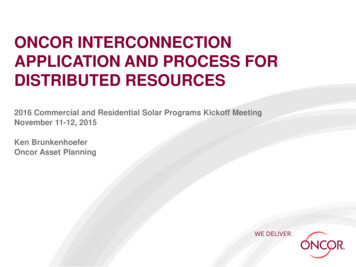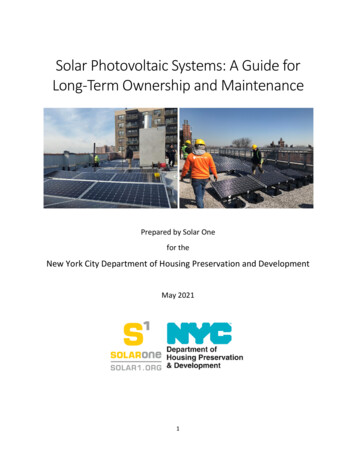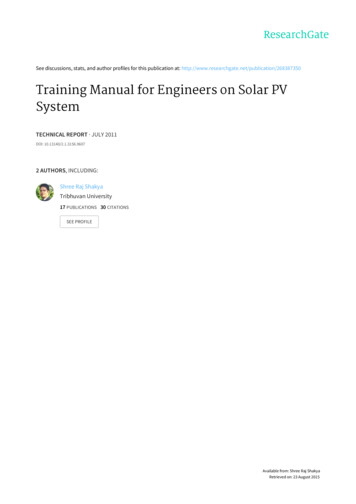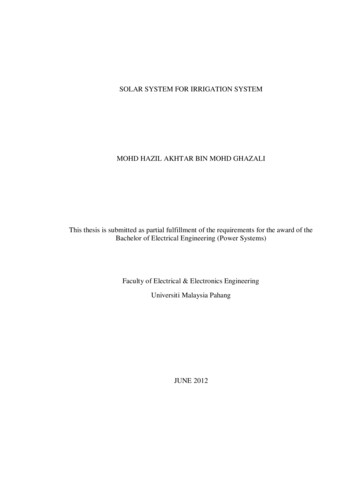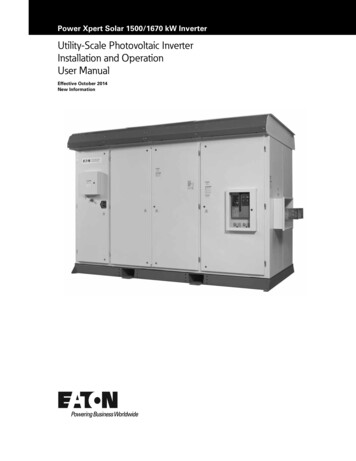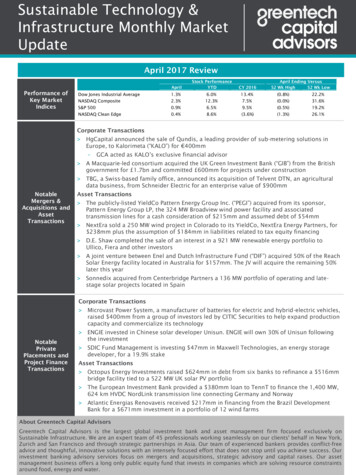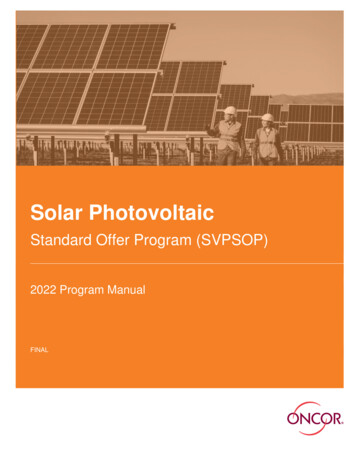
Transcription
Solar PhotovoltaicStandard Offer Program (SVPSOP)2022 Program ManualFINAL
CONTENTS1Introduction . 32Program Overview . 33Solar Photovoltaic Standard Offer Program . 43.13.2Program Options . 4Customer Eligibility . 43.2.13.2.23.3Solar Photovoltaic System Eligibility . 43.3.13.4Production Period . 8Submission Process . 94.2.14.2.24.2.34.2.4Initial Application . 9Final Application . 10Installation Notice . 11Savings Report . 12Incentive Approval . 135.15.26Program Budget . 6Incentive Calculation . 6Incentive Limits . 7Project Life Cycle . 74.14.25Interconnection Requirements . 5Incentives . 63.4.13.4.23.4.34Residential Customer Eligibility Criteria . 4Commercial Customer Eligibility Criteria . 4Project Evaluation Criteria. 13Inspections . 13Incentive Payment . 146.1Adjustments to Incentives . 147Important Program Dates and Deadlines . 158Waitlisted Projects . 159How to Participate. 159.19.29.39.4Registering as a Service Provider. 15Service Provider Application Criteria . 17Required Project Inspections for New Service Providers . 17Termination of Program Addendums . 1710 Program Links and Contacts . 18
1 INTRODUCTIONWelcome to the 2022 Oncor Solar Photovoltaic Standard Offer Program (SPVSOP or program). Theprogram offers financial incentives for the installation of eligible distributed solar energy generatingequipment and is open to all eligible residential and commercial Oncor customers. Eligiblecustomers may include residences as well as business, government, educational, nonprofit andworship facilities.As of September 1st 2021, Oncor’s Energy Efficiency Department launched a modification of theResidential Solar Photovoltaic Standard Offer Program that required Energy Storage technology asa necessary measure to qualify for Residential Solar Incentives. Oncor will continue this trend intothe 2022 program year with the aim to follow the market direction and continuously evolve theprogram. Note, this does not mean there will be incentives offered for Energy Storage systems butrather, Energy Storage systems serve as a mandatory qualifier to obtain residential solar pVincentives.Oncor is not involved in the sale or installation of energy efficiency services or renewable energysystems to its customers. Through the program, Oncor pays incentives to service providers whomarket, sell/lease and install solar photovoltaic systems to Oncor commercial and residentialcustomers. A service provider’s participation in the program does not constitute Oncor’sendorsement or approval of any company, product or service.This program complies with the standard offer program requirements published by the Public UtilityCommission of Texas (PUCT). This program manual is intended to inform service providers of theprogram requirements and processes. However, service providers should also review the PUCTrules related to energy efficiency programs and the requirements in the TRM for energy efficiencyprograms, and are required to comply with such rules and requirements.This program manual summarizes program requirements, processes, and incentives but may notaddress all scenarios. Oncor has full discretion to interpret or modify program requirements, andmay revise the program manual at any time.Visit the Oncor Energy Efficiency Program Management (EEPM) tool, available at eepm.oncor.comto access additional registered service provider resources, including service provider applications,incentive applications, savings calculators, insurance requirements and project documentation tools,as well as program rules and incentive budget updates.We are here to help! If you have any questions after reading these materials, please don’t hesitate tocontact our program help desk at 1.866.258.1874 or eepmsupport@oncor.com2 PROGRAM OVERVIEWThe primary objective of the SPVSOP is to achieve regulatory goals by incentivizing solarphotovoltaic system installations. Additionally, the program is designed to do the following: Encourage private sector delivery of energy efficiency products and services.Achieve customer energy and cost savings.Significantly reduce barriers to participation by streamlining program procedures.Encourage participation by a wide range of service providers.The program pays service providers for electric energy efficiency improvements achieved throughqualifying solar photovoltaic installations. Solar photovoltaic system incentive values are calculatedbased on the annual energy and peak demand alternating current (AC) electrical production.SPVSOP Program ManualPage 3 of 18
3 SOLAR PHOTOVOLTAIC STANDARD OFFER PROGRAMThrough the SPVSOP, Oncor offers incentives to qualifying service providers and self-sponsors whocomplete qualifying projects. This standard offer incentive is the same for all service providers in theprogram. The terms of the standard offer are further outlined in the program addendum for eachservice provider for each program option.3.1Program OptionsThe program offers two distinct options for Oncor residential and commercial customers: A Commercial Program Option is available for those customers who receive electric servicefrom Oncor at a commercial, non-residential electric rate and meet the definition of a commercialcustomer.A Residential Program Option is available for existing residential customers who receiveelectric service from Oncor at a residential electric rate.3.2 Customer EligibilityEach Oncor customer will have a 17-digit premise number (ESIID). An ESIID should appear on acustomer’s electric bill and always start with “10.” For Oncor customers, the third through seventhdigits will be either “44372” or “17699.” Commercial and residential customers served by Oncor areeligible to receive the benefits of the program, subject to the following requirements:3.2.1 Residential Customer Eligibility Criteria The site is served by Oncor under a residential rate.A permanent meter is installed on the property and the residence is considered permanent(homes under construction on a temporary meter, and mobile residences such as travel trailersare ineligible).The site is not located in a community or development classified as a solar or renewable energycommunity. This can include areas where the homeowners association or developer establishedpolicies encouraging renewable energy.The site does not have an existing solar pV system and/or energy storage technology installed.Additions to existing systems are not eligible for the incentive regardless of the size of theinstalled system and if they have or have not participated in the program.3.2.2 Commercial Customer Eligibility Criteria The site is served by Oncor under a nonresidential rate.The site contributes to the Energy Efficiency Cost Recovery Fund.The site does not have an existing solar system installed. Additions to existing systems are noteligible for the incentive regardless of the size of the installed system and if they have or have notparticipated in the program.3.3 Solar Photovoltaic System EligibilityNew solar photovoltaic systems must meet the following program requirements to be eligible forincentives: Only new eligible solar photovoltaic equipment providing energy to the customer premise throughan interconnection on the customer’s side of the electric meter qualifies for incentives.SPVSOP Program ManualPage 4 of 18
The system is connected to the grid through an Oncor permanent meter and meets criteria for anOncor interconnection agreement.The system azimuth must be between 90 and 270 degrees, as verified by Oncor inspection.The system is installed during the program production period, and construction does not beginuntil after the project is approved and funds reserved for that specific project.Residential system is installed only by approved, participating Service Providers in the Program.Customer self-installed systems are not eligible for the program.Residential systems’ installed capacity must be between 3 kW DCSTC1 and 15 kW DCSTC, butthe total installed capacity cannot exceed 15 kW DC. A project found with an installed capacity ofover 15 kW DC will be canceled and not eligible for incentives. Any exception has to be submittedto the Program Manager and approved by Oncor management.Commercial system sizes must be between 10 kW DCSTC capacity of 450 kW DCSTC, or a DCoutput less than or equal to 75% of the site’s maximum demand over the past 12 months (PMreserves the right to adjust this percentage for any project). A project found with an installedcapacity of over 450 kW DC will be canceled and not be eligible for incentives. Any exception hasto be submitted to the Program Manager and approved by Oncor management.The system is installed using generally accepted construction practices and meets all local andstate code requirements.Sites with an existing solar array are not eligible for the program.Oncor reviews and inspects all submitted systems and may cancel projects that do not meetprogram requirements or deadlines.3.3.1 Energy Storage system Eligibility Only new eligible Battery equipment storing and dispatching energy to the customer’s premisethrough an interconnection on the customer’s side of the electric meter is accepted.The Energy Storage equipment meets criteria for an Oncor interconnection agreement and mustbe interconnected to the grid.Lead Acid Batteries are not accepted as qualifiers for Residential Solar pV incentives.All Energy Storage systems must be installed outside the customer’s residence. Garages, sheds,external walls of residence are all acceptable locations to set up the energy storage system.The Battery system must be charged by the Solar pV system it is installed with.3.3.2 Interconnection RequirementsAll solar photovoltaic and energy storage systems must be interconnected at the host customer’sexpense; if applicable, to Oncor’s electrical grid. The system must comply with Oncorinterconnection requirements for distributed generation systems as defined by the PUCT. Moreinformation on the general steps for interconnection of systems can be found at the following ableEnergy.aspxArrangements regarding interconnection must be made with the Oncor representatives responsiblefor interconnection agreements as soon as possible through Oncor’s Distributive Generation andthey can be contacted at DG@oncor.com .1Kilowatts ACSTC refers to the system’s factory-rated output at standard test conditions, which assumes1,000 w/m2 of solar radiation and a 25-degree Celsius cell operating temperature.SPVSOP Program ManualPage 5 of 18
3.4 Incentives3.4.1 Program BudgetOncor has allocated the following program incentive budgets for the 2022 program year:Residential Solar Photovoltaic Program Option- 1,163,950Commercial Solar Photovoltaic Program Option - 2,038,440Oncor reserves the right to adjust the budget during the program year for each option as it deemsnecessary, at its sole discretion. Incentive funding is offered on a first-come, first-served basis,subject to the per-project and per-service provider limits described below.3.4.2 Incentive CalculationEnergy and demand savings used to calculate incentive levels are determined per the PUCT TRMbased on location, azimuth, tilt, wattage and other factors included in the TRM. Oncor will provideeach approved service provider a calculation tool to assist in estimating each potential project. Thecalculator will be available to registered service providers under the “Resources” tab on the EEPMwebsite.Solar photovoltaic system incentive values are calculated based on the annual energy and peakdemand AC electrical production. Only solar photovoltaic systems that result in net reductions of thehost customer’s energy and demand usage qualify for incentives. Qualifying savings and associatedincentives are calculated using PVWatts software and EEPM. EEPM calculations will be used for allincentive and savings amounts.PVWatts software has been approved for use by the PUCT. More information on these savingsvalues can be located in the TRM, Version 5.0, Volume 4, Section 2.3, and at either of the Additional guidance on how to enter and calculate project savings within EEPM is available inSection 4, “Project Life Cycle.”SPVSOP Program ManualPage 6 of 18
3.4.3 Incentive Limits3.4.1.1 Per-Project Incentive LimitsIncentives will be limited to a percentage of the total installed cost of the project. In no case willOncor pay incentives in an amount greater than 50% of the total project cost (as determined byOncor, in its sole discretion, based on information provided by the service provider and anysupplemental information gathered or requested by Oncor).3.4.1.2 Service Provider Incentive LimitsTo ensure incentives are available to multiple service providers, no service provider (including itsaffiliates) may reserve or receive more than 15% of the program budget for each project option. Thecaps per provider per each option will be:Residential - 116,395Commercial - 203,844Oncor reserves the right to adjust these caps during the program year.4 PROJECT LIFE CYCLEService providers may submit project applications only after applying to the program and executingthe SPVSOP addendum.It is the sole responsibility of the applicant to ensure Oncor receives all required project applicationmaterials by close of business on the applicable due date.Below is an outline of the SPVSOP application process from start to finish:SPVSOP Program ManualPage 7 of 18
4.1 Production PeriodDuring the project implementation period (the production period), the service provider performsmarketing, sales and installation activities, reporting progress on a regular basis to Oncor.Throughout the production period, the service provider may submit applications for SPVSOPincentives via oncoreepm.com. Work submitted for incentive payment must be completed onlyduring the program production period.The production period for project submittals starts at 10 a.m. Central Time (CT) on January 19th,2022, to 5 p.m. CT on November 30, 2022 or until the program funds are exhausted. Any projectstarted or completed outside of this time period will be canceled and could result in additionalpenalties to Service Provider.SPVSOP Program ManualPage 8 of 18
4.2 Submission ProcessEach project application includes information about the service provider, the host customer site anddocumentation of the project to be implemented.All applications and supplemental documentation, as required, must be electronically scanned andattached to the project under the “Attachment” tab in EEPM. It is the sole responsibility of theapplicant to ensure Oncor receives all the required project application materials by close of businesson the applicable due dates.During the program production period, service providers are limited to eight active projects within theResidential Option and Five active projects within the Commercial Option. The service provider maycreate and submit additional projects as completed projects are approved for payment. Oncorreserves the right to change this cap depending on program needs.All new service providers admitted to the SPVSOP may be required to successfully complete oneproject before additional projects may be submitted. This limitation may also be required forreturning Providers that have had critical, reoccurring issues in past program years with meetingprogram requirements. Once the initial project passes inspection, the service provider will be allowedto submit new projects.A project application will progress through the following four phases: Initial application (IA)Final application (FA)Installation notice (IN)Savings report (SR)4.2.1 Initial ApplicationAs a first step to applying for program incentives, a service provider submits an IA for Oncor toperform a preliminary review of the proposed project’s feasibility.EEPM will require site and project details, including the manufacturer, model number, and wattage ofboth the panels and inverter in order to calculate savings and the estimated incentive amount.Specifications for each of these data points will be available in EEPM when the project details areentered.After entering project and site details, submit the project electronically thru EEPM, The HostCustomer Agreement will be sent for required signatures. Customers should be encouraged to savea copy of the signed Host Customer Agreement for future reference.After attaching the signed host customer agreement in EEPM, submit the IA for Oncor review. If noissues are found during this phase, Oncor will approve the project application and reserve fundingfor the project.A document showing the Battery Installation location is required for IA approval. This confirms to theprogram manager the Battery system will be installed in a location consistent with the programmanual’s requirements.A shading study is also required for IA approval and will be attached in EEPM with submittal. Thevalue from the shading study is required to match the data inputted in EEPM using PVWatts tocalculate savings for each project.SPVSOP Program ManualPage 9 of 18
The shading study should show the annual unshaded area and azimuth for the submittedproject. The report should clearly state the annual unshaded percentage. Reports that donot have this calculated percentage will be returned to the service provider for correction.Any study not performed by an industry accepted tool, for example written or drawn byhand, will be rejected. The actual unshaded amount should match the shading % added toEEPM for each installed array. Oncor can adjust this % to match the number in theattached shading study or will reject it back to the Provider to update the reported number.An updated shading study can be added when the project is submitted for inspection if theproject design changed during construction.Multiple ArraysWhen a single site has multiple arrays installed in various directions, or differing conditions, such asshading, each array must be entered separately into EEPM. Savings and incentives will becalculated for each array.Supplemental Documentation of Project CostsDuring the IA review, you may be asked for further supplemental project information such as abreakdown of the capital cost of the project, copy of the customer’s invoice, bid proposal or contract.Pre-installation InspectionsDuring the IA review process, Oncor may conduct a pre-installation inspection of the project site.The purpose of the inspection is to verify the baseline conditions documented in the application andthe feasibility of installing the proposed equipment. Oncor will contact the service provider if requiredand complete the inspection after receipt of a complete IA. The IA process may take up to 10business days.4.2.2 Final ApplicationAfter finalizing measures and the project timeline, the service provider will then submit the FA viaEEPM. In addition, a Reservation of Funds Agreement must be signed and submitted for approval.The RFA identifies the kilowatt, kilowatt hour and incentive associated with the project in EEPM. Thiswill be the maximum incentive amount the project can receive.The program manager will review the project. If no additional information is needed, the programmanager will approve the RFA and the project can begin construction, subject to the followingdeadlines:Residential projects must be completed and submitted for inspection within 90 calendar daysof submitting the RFA.Commercial projects must be completed and submitted for inspection with 120 calendar daysof submitting the RFA.The completion dates may be extended one time for up to an additional 45 days at the discretion ofthe program manager. Any other extension will be at the discretion of Oncor’s energy efficiencymanagement and will have to go through the Beyond 30-day extension process which will requirewritten explanation and extra documentation highlighting reasons why an extension is needed.After 30 calendar days of approved incentive reservation, Oncor reserves the right to request proofof materials purchased and/or proof that customer funding has been secured. Failure to provide therequested information may result in the cancellation of the project and release of the reserved funds.SPVSOP Program ManualPage 10 of 18
Rejected Final ApplicationsIf any of the submitted project requirements are not completed and/or any other documentationuploaded by the service provider is not of sufficient detail to complete the pre-inspection, the projectwill be rejected. Oncor will allow the service provider 15 business days to resubmit for a secondreview or the project can be canceled.Notifications thru EEPM of approval, rejection or of any needed corrections or updates to the FA.4.2.3 Installation NoticeOnce installation is complete, the service provider is required to provide information in EEPM for theinstalled solar photovoltaic system. All documents submitted for inspection are required to reflectfinal installation. Documentation shall include: A signed and dated Installation Notice (IN) to be submitted electronicallyDigital photograph(s) of all installed components of the system, including:oooooo All installed arrays showing all installed panels.The back of one panel showing manufacturer, model number and wattage.Inverter nameplate showing manufacturer, model number and wattage.A photo of the tilt measurement (e.g photo of inclinometer reading or phone app showing tiltdegree measurement.)Up close Battery Model NumberProfile of Installed Energy Storage SystemSpec Sheet of the Battery ModelDocument showing Battery is being charged by Solar pV system.Document showing Hours of Dispatch for battery set by installer.A copy of the installation invoice for the solar photovoltaic system. The invoice must includedetailed information on the specific equipment installed, including the manufacturer and model ofthe solar panels and inverter(s)An updated shading study if the array installed after the project was approved in the IA phasewas changed reflecting any shading percentagesAfter all required documents are attached in EEPM; Provider will submit the IN to notify the ProgramManager that the project is ready for post-inspection.Service providers should allow up to 20 business days for the inspection to be completed. Allprojects must be fully installed and construction complete before it is submitted for inspection. Anyproject not fully installed will be rejected and sent back to the service provider.Once a project is post-inspected and approved by the program, you will be notified via EEPM thatyour project has been inspected and approved. A project can also be rejected back to the ServiceProviders if major issues are discovered and need correction. The Service Provider will then correctand resubmit the project for a second review.On-Site InspectionsOncor may conduct an on-site post-inspection of any project. Oncor will schedule a time and date forany inspection with the host customer and may require the service provider to be present. Theservice provider must provide the inspector with access to the solar panel installation site inspectionas needed. The Service Provider shall be available to meet the inspector on site for all commercialinspection as requested by the Inspection team.SPVSOP Program ManualPage 11 of 18
Desk Review InspectionsDue to the pandemic, all on-site inspections have been suspended. All inspections will be conductedthrough desk review with the exception of a select few. The inspection manager has the discretion todecide what project he would like to conduct an on-site inspection on. Introduction of desk reviewinspection means documentation provided by the service providers must meet a standard that isacceptable by the program manager and Inspection manager to properly conduct a desk review. Forexample, photos that do not clearly show the exact number of panels in an array, or a clear image ofthe model number at the back of a single panel will be rejected back to the service provider.Missing or Requested Additional DocumentationIf any of the service provider actions listed above are not completed, or the photographs or otherdocumentation uploaded into EEPM are not of sufficient detail for the program to complete the postinspection, the project will be rejected. Oncor will allow the service provider an opportunity to remedyand resubmit the information required for the post-inspection.Oncor reserves the right to require additional information for the project to complete the postinspection. Oncor also reserves the right to disqualify the project or allow the service provider to takecorrective action if issues with the project measure installation are found. Repeated errors or thesubmittal of false information or evidence the project was completed before it was approved forconstruction could result in the service provider being prohibited from submitting new projects orfrom future participation in Oncor’s energy efficiency programs.4.2.4 Savings ReportAfter passing post-inspection review, Provider will generate and submit an SR under the “PrintDocuments” tab in EEPM for electronic submittal. The SR is the primary reporting instrument usedthroughout the production period, serving as an invoice to the program for project incentives. SRsinclude project information, energy savings, incentive payment, other supporting data and theservice provider name and signature. SRs are generated from the installation data inputs after thepost-inspection is complete. No additional data inputs are required to generate these reports.Oncor will not make any incentive payments for any savings not included in a SR. Work submittedfor an incentive payment must be completed only during the program production period.Oncor may adjust the SR based on findings from inspections. The total incentive paid will not exceedthe amount approved in the RFA. This final incentive amount can decrease depending on the finalinstallation and inspection results. The SR will never exceed the reserved amount.In the event the service provider disagrees with the payment adjustment, the service provider mayrequest all information be reviewed again after additional information is provided by the serviceprovider. Final payment adjustments will be at the sole discretion of Oncor.The SR must be signed and submitted electronically which will be attached under the “ProjectAttachments” tab in EEPM.After submission of the SR, the program will request any additional information needed, or approvethe SR and process the incentive performance payment.SPVSOP Program ManualPage 12 of 18
5 INCENTIVE APPROVALOnce the IA, FA, IN, SR and accompanying documentation is submitted in EEPM to Oncor, they willbe reviewed for feasibility of the proposed measures and the accuracy of
Oncor has allocated the following program incentive budgets for the 2022 program year: Residential Solar Photovoltaic Program Option- 1,163,950 Commercial Solar Photovoltaic Program Option- 2,038,440 Oncor reserves the right to adjust the budget during the program year for each option as it deems necessary, at its sole discretion.
